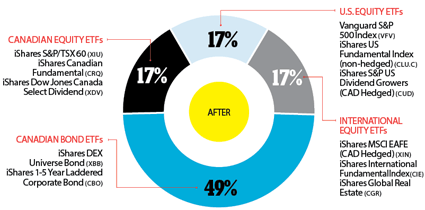Getting them back to balanced
John and Kirsty Dales are where most Canadians wish they could be: mortgage-free with a good pension and a healthy nest egg to fund their retirement. But their ultra-conservative RRSPs could stand in their way.
Advertisement
John and Kirsty Dales are where most Canadians wish they could be: mortgage-free with a good pension and a healthy nest egg to fund their retirement. But their ultra-conservative RRSPs could stand in their way.
![Portfolio_Builder_banner_1256X300[2][2][2]](https://www.moneysense.ca/wp-content/uploads/2016/05/Portfolio_Builder_banner_1256X300222.jpeg)

John Dales retired from a stressful job at 57 after his wife Kirsty said “she’d rather have me poor than dead.” The good news is the couple is far from poor: they have a paid-for home in Northern Ontario, their children have left the nest, and Kirsty will receive $45,000 a year from her defined-benefit pension when she retires from the public service next May. But their $500,000 RRSPs are very conservatively invested in savings accounts, GIC rates and bond funds unlikely to deliver more than 2% a year. They plan to spend $60,000 annually in retirement, and they’re not sure such a low-yield portfolio will be able to sustain their lifestyle.

The challenge for this couple is as much about broad financial planning as investing, so we consulted veteran financial planner Warren Baldwin of Toronto-based T.E. Wealth.
John and Kirsty will each receive reduced Canada Pension Plan benefits at age 60, with full Old Age Security at 65. Their only debts—for a car and a home renovation—will be paid off in two and four years, respectively.
Their government benefits, along with Kirsty’s pension, will go a long way to meeting their retirement spending goal of $60,000 (adjusted for 2% inflation annually). But Baldwin estimates they will need to achieve 5% annual investment returns if they want to make their portfolio last until age 90. Unfortunately, with today’s interest rates they can’t hit that target with their current mix of 90% cash and fixed income. “Their portfolio looks as if it were pulled out of the markets in the last financial crisis and never fully returned,” Baldwin says.
He suggests the couple should shift the portfolio to something more balanced: roughly half stocks and half fixed income (including the addition of corporate bonds) to get closer to the goal of 5% returns with moderate risk.
An all-ETF portfolio provides broad diversification and extremely low costs, T.E. Wealth financial planner Matt Ardrey says. “This will be uncomplicated enough to manage on their own while still providing adequate diversification through asset classes, geographic regions and company size.”
Do you want a portfolio makeover from MoneySense? If so, send an email describing your situation to [email protected]
Share this article Share on Facebook Share on Twitter Share on Linkedin Share on Reddit Share on Email